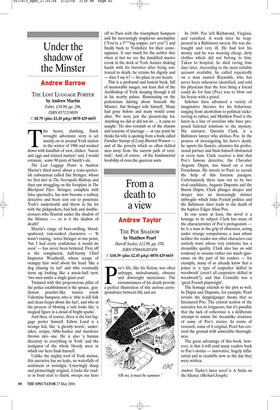From a death to a view
Andrew Taylor
THE POE SHADOW by Matthew Pearl Harvill Secker, £12.99, pp. 370, ISBN 9780436205459 ✆ £10.39 (plus £2.45 p&p) 0870 429 6655 Poe’s life, like his fiction, was often unhappy, melodramatic, obscure and downright mysterious. The circumstances of his death provide a perfect illustration of this curious correspondence between life and art. In 1849, Poe left Richmond, Virginia, and vanished. A week later he reappeared in a Baltimore tavern. He was distraught and very ill. He had lost his money and he was wearing cheap, dirty clothes which did not belong to him. Taken to hospital, he died raving four days later. According to the most reliable account available, he called repeatedly on a man named Reynolds, who has never been otherwise identified, and told his physician that the best thing a friend could do for him (Poe) was to blow out his brains with a pistol.
Scholars have advanced a variety of imaginative theories for his behaviour, ranging from alcoholism to political racketeering to rabies; and Matthew Pearl is the latest in a line of novelists who have proposed fictional solutions to the mystery. His narrator, Quentin Clark, is a Baltimore lawyer who idolises Poe. In the process of investigating his hero’s death, he upsets his fiancée, alienates his professional partner and finds himself obstructed at every turn. Clark receives a hint that Poe’s famous detective, the Chevalier Auguste Dupin, was based on a real Frenchman. He travels to Paris to recruit the help of this forensic paragon. Unfortunately there turn out to be two rival candidates, Auguste Duponte and the Baron Dupin. Clark plunges deeper and deeper into an increasingly sinister imbroglio which links French politics and the Baltimore slave trade to the death of the hapless Edgar Allan Poe.
In one sense at least, the novel is a homage to its subject: Clark has many of the characteristics of Poe’s protagonists he is a man in the grip of obsession, acting under strange compulsions; a man whom neither the reader nor other characters can entirely trust; whose very existence has a dreamlike quality. Clark also has an odd tendency to assume rather too much ignorance on the part of his readers — for example, many of us already know that a joiner is ‘a type of carpenter skilled in woodwork’ (aren’t all carpenters skilled in woodwork?), and that Corneille was a ‘great French playwright’.
The homage extends to the plot as well. In Dupin and Duponte, for example, Pearl revisits the doppelganger theme that so fascinated Poe. The central section of the narrative has its longueurs, but it’s possible that the lack of coherence is a deliberate attempt to mimic the dreamlike structure of some of Poe’s stories. In terms of research, some of it original, Pearl has covered the ground with admirable thoroughness.
The great advantage of this book, however, is that it will send many readers back to Poe’s stories — innovative, hugely influential and as readable now as the day they were written.
Andrew Taylor’s latest novel is A Stain on the Silence (Michael Joseph).










































































































 Previous page
Previous page